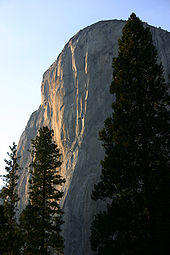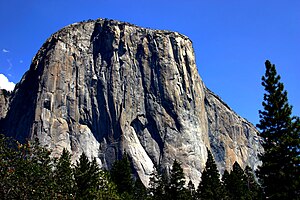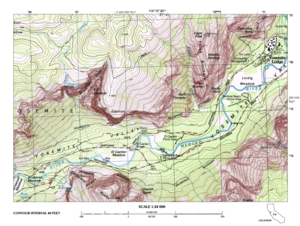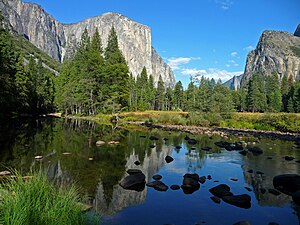El Capitan (California)
| El Capitan | ||
|---|---|---|
|
Southwest face of El Capitan |
||
| height | 2307 m | |
| location | Mariposa County , California , USA | |
| Mountains | Sierra Nevada | |
| Coordinates | 37 ° 44 '2 " N , 119 ° 38' 13" W | |
|
|
||
| Type | Ledge | |
| rock | mostly granite | |
| Age of the rock | Border area Lower Cretaceous - Upper Cretaceous (approx. 100 million years) | |
|
Topographic map of the Yosemite Valley |
||
|
View from the west up the Yosemite Valley, with El Capitan in the middle ground on the left and the Merced River in the foreground |
||
|
View from the south, from the south bank of the Merced River |
||
El Capitan is a prominent rock outcrop in Yosemite National Park in the US state of California . Its partly vertically sloping flanks rise up to 1000 meters above the Yosemite Valley, on the north side of which it lies. The highest point of the rock is at 2307 meters above sea level . Due to its dimensions, El Capitan is a striking landmark in the Yosemite Valley. It is considered one of the landmarks of the national park. Its rock walls make it a magnet for climbers .
etymology
The name El Capitan comes from Spanish and means something like 'leader' or 'captain'. It is said to have been coined in 1851, relatively shortly after the annexation of California by the USA, by members of the Mariposa Battalion, a troop of US settlers who were the first whites to enter the Yosemite Valley. The tradition of the etymology comes from Lafayette Bunnell, a member of this troupe. According to him, El Capitan is said to be derived from the name Tu-tock-ah-nu-lah from the language of the Ahwahnee , an ethnic group of the Paiute Indians and indigenous people of the Yosemite Valley. Tu-tock-ah was the name of a chief of the Ahwahnee. The natives had named the rock after one of their chiefs, from which the whites then made the 'chief rock' El Capitan .
morphology
El Capitan is not a mountain in the strict sense of the word. It slopes virtually vertically to the west, southwest and southeast and relatively gently to the east to the Merced River in the Yosemite Valley and the gorges of its tributaries. In the west this is a tributary of Ribbon Creek, in the east Eagle Creek. Its "ridge line" runs near the western flank approximately north-northeast-south-southwest. To the northeast, however, El Capitan adjoins the high plateau, which is cut by the Yosemite Valley, largely inconspicuously. In addition, the steep face continues in the valley both to the east and west. Strictly speaking, one can only speak of a ledge in the steep valley wall, even though it has considerable dimensions with a total of almost 2500 meters wide * and up to 1000 meters high.
geology
The rock of El Capitan is part of the Sierra Nevada batholith, a complex igneous rock that makes up much of the Sierra Nevada. The batholith was formed in the Mesozoic Era and is considered to be evidence of the subduction of the Farallon Plate under the North American Plate . El Capitan consists of two granites that differ slightly from one another in terms of mineral content : the approximately 105 million year old El Capitan granite and the taffeta granite, which is a little younger at around 103 million years. In addition, it is penetrated by dikes of granodiorite and mafic rocks, which are some of the most recent at around 99 million years old. Late magmatic aplitic and pegmatic gaits are also detectable .
El Capitan is often referred to as a " monolith ", especially in a popular context . However, the rock does not consist of just one type of rock, but of several igneous rock types, which differ in composition and / or structure. It is also morphologically not really independent, in contrast to other objects that are often referred to as monoliths, such as Mount Augustus in Australia. Since the term “monolith” is not clearly defined and is used differently in different contexts, the term “monolith” should generally be avoided in the case of mountains, rocks etc.
Climb

Although the highest point of El Capitan can be reached via an easy hiking trail, the challenge for climbers is to climb one of the steep granite walls criss-crossed by numerous long and difficult climbing routes .
The most famous route on El Cap , as it is often abbreviated among climbers, is probably The Nose on the south edge, which was opened in 1958 by Warren Harding , Wayne Merry and George Whitmore after a total of 47 climbing days spread over 17 months in technical climbing . Because of the natural line it follows and its length and exposure, it is still the dream destination of many climbers today.
Throughout the 1960s, numerous efforts were made on all of the walls of El Capitan, which eventually led to the realization that each of the walls could be conquered with enough tenacity and bolts . After this realization, some of the climbers began to refuse to move with bolts and to look for routes that could be climbed freely or with as little technical climbing as possible. Although this ethic prevailed and the number of free climbing attempts increased, it was not until 1979 that the exposed west face had a freely traveled route. Ray Jardine succeeded in this ascent . The nose could only be climbed freely for the first time in 1993 by Lynn Hill .
Even today, El Capitan is always the scene of outstanding climbing achievements: New and more difficult lines are still being opened up or old routes, which used to be only technically climbable, are being freely climbed:
On June 17, 2004 the brothers Alexander and Thomas Huber were able to set their own record for the fastest ascent of a route on El Capitan in the Route Zodiac to 1:51:34 hours. Usually rope teams need three to four days for such a route. The Nose is even more important for speed climbing : The current best time is 1:58:07 and was achieved by Alex Honnold and Tommy Caldwell on June 6, 2018.
From December 27, 2014 to January 14, 2015, Tommy Caldwell and Kevin Jorgeson managed the first ascent of the Dawn Wall route in free style . The route is considered to be one of the most difficult multi-pitch routes in the world.
On June 3, 2017, Alex Honnold managed the first free solo ascent on El Capitan, on the Freerider route in less than four hours.
While trying to set a new speed record, 48-year-old Jason Wells from Colorado and Tim Klein from California, both experienced El Capitan climbers, both died on June 2, 2018 on the so-called Freeblast route.
Base jumping
The 1000 meter high, partially overhanging southwest face of El Capitan makes it an ideal place for base jumps . Michael Pelkey and Brian Schubert made the first base jump from the summit of El Capitan on July 24, 1966, when both jumpers broke bones. After equipment and technology had improved significantly in the 1970s, many base jumpers jumped successfully and safely from the El Capitan.
In 1980 the national park administration tried to regulate the number of jumps by issuing jump permits. As some of the jumpers grossly violated the rules in force in the national park, the administration finally stopped granting permits and banned base jumping on El Capitan and in the entire national park. Since then, a number of groups have formed to campaign for the reopening. On October 23, 1999, the base jumper and stunt woman Jan Davis was killed in an illegal jump that was undertaken as a protest against the ban, but was tolerated by the park officials.
Trivia
- In 1988/89 the rock was used as a location for the movie Star Trek V: At the Edge of the Universe .
- The song El Capitan by the Scottish indie band Idlewild is about El Capitan.
- The film Am Limit documents the Huber brothers ' attempt to break the speed record on the nose.
- The film Free Solo documents Alex Honnold's first free solo ascent of the Freerider route .
- The film The Dawn Wall documents the first free-style ascent of the Dawn Wall route by Tommy Caldwell and Kevin Jorgeson
- Version 10.11 of Apple's OS X operating system was named El Capitan .
Remarks
- * Distance between Ribbon Creek and Eagle Creek at the level of the southwest and southeast walls of the Capitan parallel to the course of the valley
Web links
Individual evidence
- ^ Peter Browning: Yosemite Place Names: The Historic Background of Geographic Names in Yosemite National Park. 2nd Edition. Great West Books, Lafayette (CA) 2005, ISBN 0-944220-19-3 , p. 41 (English).
- ^ Roger Putnam, Allen F. Glazner, Drew S. Coleman, Andrew RC Kylander-Clark, Tamlin Pavelsky, Miquela I. Abbot: Plutonism in three dimensions: Field and geochemical relations on the southeast face of El Capitan, Yosemite National Park, California . Geosphere, July 2015, doi : 10.1130 / GES01133.1 ; see also Roger Putnam: Understanding plutonism in three dimensions: Field and geochemical relations on the southeast face of El Capitan, Yosemite National Park, California. MSc thesis, University of North Carolina at Chapel Hill, 2013 ( online ) (both in English).
- ↑ Robert P. Bourman, Clifford D. Ollier, Solomon Buckman: Inselbergs and monoliths: a comparative review of two iconic Australian landforms, Uluru (Ayers Rock) and Burringurrah (Mount Augustus). Journal of Geomorphology. Vol. 59, No. 2, 2015, pp. 197–227, doi : 10.1127 / 0372-8854 / 2014/0148 , (alternative full text access : ResearchGate ) (English).
- ↑ Tom Frost: A Climber Returns to El Capitan. Yosemite Guide. Vol. 30, No. 2, 2005, pp. 0–1 ( PDF ( Memento of July 10, 2007 in the Internet Archive ) 1.3 MB) (English).
- ^ New Speed Record on the Zodiac. In: bergstieg.com. July 2, 2004, accessed May 11, 2007 .
- ↑ Alex Honnold and Tommy Caldwell Set Sub-2-Hour Nose Speed Record . In: Climbing Magazine . ( climbing.com [accessed June 7, 2018]).
- ↑ Stephanie Geiger: Even faster at the "Nose" In: Frankfurter Allgemeine Zeitung of June 7, 2018, accessed on June 22, 2018.
- ↑ El Capitan in California: climbers conquer legendary rock face. In: Spiegel Online , January 15, 2015.
- ↑ El Capitan's Dawn Wall: Coverage of the Ascent at Yosemite. In: New York Times , January 14, 2014 (English).
- ↑ Chris Van Leuven: Free at Last: Caldwell, Jorgeson Top Out the Dawn Wall. In: alpinist.com. January 14, 2014, accessed January 15, 2015.
- ↑ Frankfurter Allgemeine Sonntagszeitung No. 51, December 24, 2017, p. 40.
- ↑ Climbers fall to their deaths on El Capitan In: Spiegel Online , June 3, 2018.
- ↑ BASE jumping. In: baseclimb.com. Archived from the original on April 3, 2013 ; accessed on August 13, 2015 .
- ^ Marianne Costantinou, Gregory Lewis: Death fall from El Capitan. In: San Francisco Chronicle , October 23, 1999.
- ↑ Apple OS X Preview on apple.com, accessed June 9, 2015.






